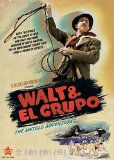In the 1940’s Walt Disney was asked by President Roosevelt to take a goodwill tour across Latin America as an ambassador of sorts. He declined the invitation, protesting that he wasn’t the handshaking kind and that the cause would be better served using someone else. Not to be deterred, Roosevelt made a counteroffer. What if Walt would go to Latin America with a film contingent and then create some kind of a production out of the tour. A government subsidy was even offered. Walt accepted the invite but turned down the subsidy. And so, with a large party of animators, writers, and production crew, they took a whirlwind tour and left with what Walt himself described as a wealth of material. The footage obtained and the experience gained would feed into Disney productions for decades.
Of more immediate reward came a 40-minute feature called Saludos Amigos, released in 1940. Set to some wonderful music, the short piece featured Donald Duck and a new Disney creation inspired by the trip, a parrot named Jose Carioca. Most of the film uses the footage shot during the Disney tour and acts mostly like a travelogue. Donald’s antics are mixed in during several segments. He gets to interact with the live footage, and the result is impressive, particularly for 1942.
The Three Caballeros is just over an hour and is the more commercial and kid-friendly of the features. Again there are live action sequences often intercut with Donald and his fellow caballeros Jose Carioca and Panchito, a rooster. These three sing and dance their way through various Latin American locales. This one has more of a story thread with the journey kicked off when Donald receives presents for his birthday. These presents include a reel of film and a Brazil travelogue that get Donald right into the spirit of things. There’s plenty of singing and dancing, and your kids are likely to memorize the title song in no time; isn’t that just great?
The documentary follows the adventures of the Disney group through remembrances of those family members who survive and the folks the group touched in South America. Family members read from letters that were sent back from the travelers that describe the encounters in vivid detail. We retrace many of the steps and see how some of the locations that were described look today.
It was a tough time for Walt personally, and that is captured in detail here. Just before he left, many of his animators had gone out on strike. It was a power play by a union boss who wanted to unionize Disney’s animators without a shop vote. Walt called their bluff, only it wasn’t a bluff. Walt’s father died while he was on the trip, but he continued on with the 3-month visit.
There’s plenty of vintage footage here. There are stills and other memorabilia to tell the story. It is a bit overlong. The last 20 minutes feels completely like padding. There are too many musical montages.
Extras include more footage and an uncut version of Saludos Amigos. In this version Goofy is seen smoking a cigarette, which was quickly removed from the film during its wide release.
The term came from the necessity of having Porter’s call the group to meetings and gatherings. He would shout: “El Grupo” to hail the Disney travelers together. After all “there were no cell phones at the time”.



